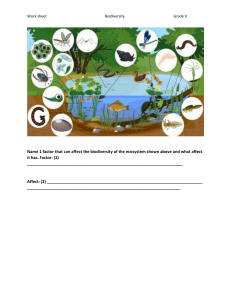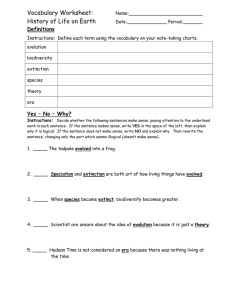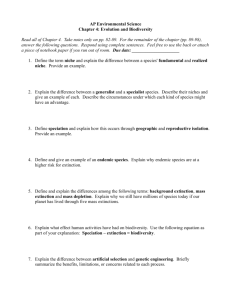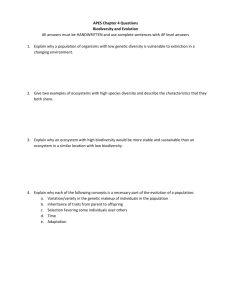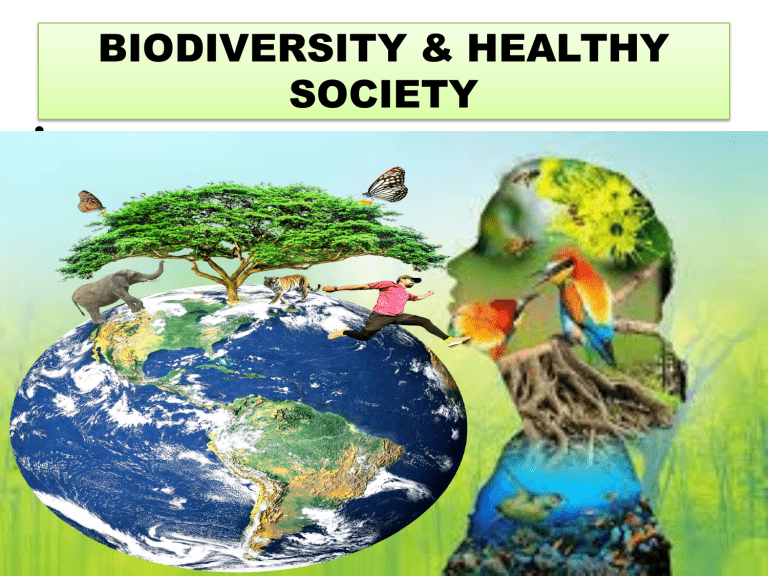
BIODIVERSITY & HEALTHY SOCIETY • • Biodiversity or biological biodiversity is term that describes the variety of living beings on earth. • It encompasses microorganisms, plants, animals & ecosystems such as coral reefs, forests, rainforests, deserts, etc. • It also refers to the no. or abundance of different species living within a particular region. • It represents the wealth of biological resources available to us. • It represents the wealth of biological resources available to us. It is all about sustaining the natural area made up of the community of plants, animals, & all other living things, which is beginning to reduced at a steady rate as we plan human activities that are reduced by habitat destruction SPECIES DIVERSITY ECOLOGICAL DIVERSITY GENETIC DIVERSITY 1. GENETIC DIVERSITY • This pertains to variation in genes contained by organism. • Genetic diversity deals with the measure of the variety of the different versions of the same genes within individual species. • It includes the genetic variations within species, both among geographically separated populations and among individuals within a single population . 2. SPECIES DIVERSITY • This denotes about variety of species within a community. • Species diversity describes the number of different kinds of organisms within individual communities of ecosystems. It includes a full range of species from microorganisms to giants and mammoth varieties of plants and animals, e.g., single celled viruses and bacteria etc., and multi-cellular plants, animals and fungi. 3. ECOSYSTEM DIVERSITY • • This refers to variation among groups of organisms in terrestrial & aquatic environments. Ecological diversity assesses the richness and complexity of a biological community including the number of niches, tropic levels, and ecological processes that capture the energy, sustain food webs, and recycle materials within this system. It studies variation in the biological communities in which species jive, exist and interact. yFOREST DESERT GRASSLAND CORAL REEFS THREATS TO BIODIVERSITY • • • • • • Extinction the elimination of species, can be a normal process of the natural world as species out-compete or kill off others as environmental conditions change such as during the Ice Ages. There have been five mass extinction events. These are referred as “bottlenecks” in biodiversity. These events have been documented by fossil records that most of the species that ever existed die out & are replaced by other often by their descendants as part of evolutionary change. Over the past 150 years, species are going extinct at an accelerated and dangerous rate because of human activities From a natural extinction rate of one to five per year, the extinction rate has increased to thousands per decade. Conservation biologists call this “sixth mass extinction”. But this time, it is not asteroids, ice age or volcanoes, but human impact. A population bottleneck is an event that drastically reduces the size of a population. The bottleneck may be caused by various events, such as an environmental disaster, the hunting of a species to the point of extinction, or habitat destruction that results in the deaths of organisms. . THE IMPORTANCE OF BIODIVERSITY • Biodiversity is extremely important to people, society, and the health of the ecosystems. It can aid ecosystem stability and because we rely on many different organisms. A few of the reasons are: Biodiversity provides food and medicines ● Plant and animal species make important contributions to human food supplies. Some pharmaceutical products are derived from plants, animals, and microbes. In an article of Montenegro (2015), a newly discovered PHL medicinal plant was featured in honor of Pope Francis. A team from UST Graduate School and Research Cluster for the Natural and Applied Sciences headed by Dr. Grecebio Alejandro have named the plant Hedyotis papafranciscoi Alejandro, sp. nov. In honor of Pope Francis who visited the Philippines in 2015. ● could be used to treat cancer, fever, malaria, and rheumatism. THE IMPORTANCE OF BIODIVERSITY Biodiversity is extremely important to people, society, and the health of the ecosystems. It can aid ecosystem stability and because we rely on many different organisms. A few of the reasons are: Biodiversity can aide ecosystem stability ● Maintaining biodiversity can be essential in existence of other species and other ecological functions. ● Crocodiles are important in the river's ecosystem. Their excretions fertilize the riverbeds. These help propagate planktons, which fishes eat". Suggested Video: CROCODYLUS (full episode): bit.ly/2ugUkWz In a documentary video of I-Witness (July 2017), "Around 100 Philippine Crocodile (Crocodylus Mindorensis) (see right) are left in the world. Their disappearance is linked to the destruction of Mangrove's Forest. fishing Biodiversity Aesthetic & existence values are important ● Nature appreciation is economically important. ● It provides job opportunities to local communities. ● Nature-based activities like fishing, hunting, camping and hiking also have cultural value. ● Contact with nature can be emotionally uplifting. For some, it has religious and moral significance. hunting camping hiking Threatened Species ● Any species that is becoming rare and that may become in danger of extinction. ● Any Criteria to use to classify Threatened Species 1. 2. 3. 4. Present destruction and modifications of their habitat Natural or man-made factors. Population size reduction. Species’ geographic range. Biodiversity Loss ● EXTINCTION- the last individual member of the species dies; no species exists. ● CAUSES OF EXTINCTION 1. 2. Natural- Environmental factors Anthropogenic- man-made. Natural Causes of Extinction: 1. 2. 3. Natural- Environmental Change on landscape (Global Warming & Climate Change Meteor Impact & Cosmic Radiation Extreme heating & Cooling of the earth’s surface. E.O Wilson summarizes human threats to biodiversity as HIPPO, which stands for •H •I •P •P •O Habitat destruction Invasive Species Population Growth Pollution Overharvesting ANTHROPOGENIC CAUSES OF EXTINCTION H Habitat destruction- primary cause of extinction (e.g. deforestation, oil spills) ANTHROPOGENIC CAUSES OF EXTINCTION I Invasive Species- species that are introduced by Humans to affect another species. • Population Growth- resources are over-used causing destruction in the environment. ANTHROPOGENIC CAUSES OF EXTINCTION P Pollution (Acid Rain) due to concentration of sulfur Dioxide in the atmosphere ANTHROPOGENIC CAUSES OF EXTINCTION P Pollution (Ozone depletion) due to chloroflourocarbons (CFC) ANTHROPOGENIC CAUSES OF EXTINCTION P Pollution (Eutrophication) –build-up of excessive Nutrients in bodies of water; results to fish kill ANTHROPOGENIC CAUSES OF EXTINCTION O Overexploitation –getting more than what is really needed. Genetically Modified Organisms • Organisms have different characteristics because of the variety of genes expressed. • The technology allows insertion of a desired trait to an organisms through the process of recombinant DNA technology (Genetic Engineering) • Genetic Engineering is the process of adding a foreign DNA to the genome or all genetic material of another organisms. • Genetically modified organism (GMO) is an organism or microorganism whose genetic material has been altered to contain a segment of DNA from another organism. • HERBICIDE-RESISTA NT PLANTS • Using herbicides may have killed the weeds around the plant but it also has an adverse effect to crops. • Scientists were able to develop the characteristic of plants where they can tolerate the chemicals in the herbicides. Thus, the surrounding weeds are killed and leave the main crop unaffected. THE IMPACT OF GMO TO BIODIVERSITY AND ENVIRONMENT • • • • • • • The basic goal of biotechnology is to provide the means to feed the world's hungry. Moreover, the benefit of GMO in the increase of the crop yield is well established. Alarming results have been produced in several recent studies indicating the toxicity and harm to health and ecology. The following summarizes the effect: An insect resistant GM crop could have direct toxic effect on non-target species. A GM crop could have an indirect effect to other species by reducing the source of food for other wildlife such as birds. Pest resurgence could be resulted from insects which become resistant to chemicals when used on pest tolerant GM crops repeatedly and may increase the number of insect pest. Creating an imbalance in nature by changing the predator/prey ratio.
